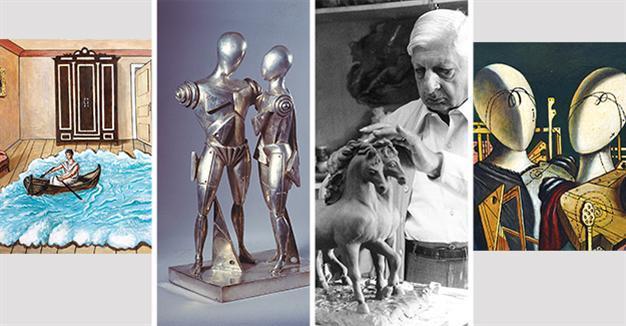‘Enigma of the World’ at Istanbul’s Pera Museum
ISTANBUL
 An exhibition showcasing iconic Italian painter Giorgio de Chirico, one of the most extraordinary artists of the 20th century, has opened at Istanbul’s Pera Museum.
An exhibition showcasing iconic Italian painter Giorgio de Chirico, one of the most extraordinary artists of the 20th century, has opened at Istanbul’s Pera Museum.Realized in collaboration with the Fondazione Giorgio e Isa de Chirico in Rome, “The Enigma of the World” includes a broad selection of 70 paintings, two lithography series, and 10 sculptures by de Chirico.
De Chirico’s father Evaristo de Chirico was born in Istanbul, and the exhibition perhaps represents an ideal return and an occasion of genuine discovery.
Istanbul was the de Chirico family’s city of residence while Giorgio’s grandfather, Giorgio Maria, worked as a dragoman (diplomatic interpreter) for the Sublime Porte.
During the years he studied at the Munich Academy of Fine Arts between 1906 and 1909, de Chirico was influenced by the works of philosophers such as Nietzsche, Schopenhauer, and Otto Weininger, as well as the art of Arnold Böcklin and Max Klinger.
His invention of “Metaphysical Art” in Florence in 1910, his theoretical writings, and the corpus of his early period metaphysical paintings, would prove to be a strong source of inspiration for the Surrealists.
The artist focused on the subjects of memory, dreams, and the enigma of the world. He was a trailblazing, multitalented artist who had a profound impact on other masters like Magritte and Dali.
The exhibition design retraces almost 70 years of de Chirico’s artistic career from the dawn of Metaphysical Art to the iconographic themes of the 1920s and 1930s, to research into classical painting technique, up to the splendid ultimate period of Neo-metaphysical Art of 1968-1976 in which a renewed painterly, conceptual and philosophical vision comes to light in works in tune with contemporary Pop Art.
The exhibition brings together a striking collection of extraordinary inventions and recurrent innovations, which, seen as a whole, bring to mind Nietzsche’s idea of “Eternal Return.”
As Fabio Benzi, the curator of the exhibition mentions in his article in the exhibition catalogue, “Among the foremost artists of the 20th century avant-garde, in 1910, de Chirico fine-tuned a vision, ‘Metaphysical Art,’ which together with those of his contemporaries Picasso, Matisse, Kandinsky, Balla and Malevic, constitute the great pillars of contemporary art.”
De Chirico is one of the most extraordinary figures of the 20th century, a period marked by consecutive avant-garde movements. During this rich period that brought to fore different forms and modes of expression rather than themes in painting, de Chirico created a unique metaphysical universe in which he developed a variegated complexity of subjects. His “Metaphysical Art” was seminal and eye opening both for his contemporaries and for the subsequent generations.
Throughout his 70 year-long career, de Chirico moved from hermetic representations and images evoking the pathos of antiquity, to works akin to great classical painting, to paintings of a luminous naturalism, and other brilliantly ironic and playful images.
At 80 years of age he revisited his most iconic subjects such as the Italian Piazza, the Mannequin and the Metaphysical Interior, newly interpreting these with bright colors and serene atmospheres compared to the severe and disquieting ones of his early years.
The exhibition at Pera Museum, which can be visited until May 1, sheds light upon the artist’s unique, free and endless search and the artistic adventure he undertook, and which would reshape the course of 20th century art.
















